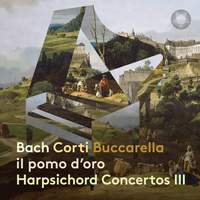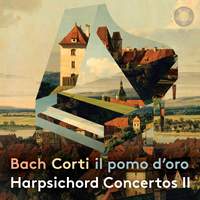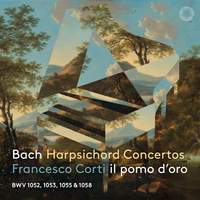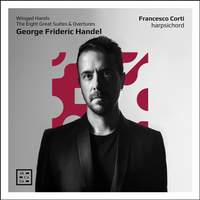Interview,
Francesco Corti on Bach
 The vitality and imagination on display in Francesco Corti's ongoing survey of JS Bach's keyboard concertos on Pentatone won me over right from the first instalment back in spring 2020, and the latest volume sees the Italian harpsichordist and conductor also channelling his creative energy into reconstruction - the third concerto on the album, BWV 1059, has been expanded by Corti and Francesco Zimei from a nine-bar fragment which has also piqued the interest of musicologists including Arnold Mehl and Gustav Leonhardt over the years...
The vitality and imagination on display in Francesco Corti's ongoing survey of JS Bach's keyboard concertos on Pentatone won me over right from the first instalment back in spring 2020, and the latest volume sees the Italian harpsichordist and conductor also channelling his creative energy into reconstruction - the third concerto on the album, BWV 1059, has been expanded by Corti and Francesco Zimei from a nine-bar fragment which has also piqued the interest of musicologists including Arnold Mehl and Gustav Leonhardt over the years...
I met up with Francesco over video-call last month to talk about the pleasures and challenges of reconstructing an entire concerto from a single page of music - plus the one thing he'd never do when interpreting Bach, and how the composer's resourcefulness resonates with his own 'very Italian common-sense practical side!'.
As well as multi-tasking as soloist and director, you've also turned your hand to reconstruction for this latest instalment of the project...
This third volume contains one major reconstruction, BWV1059, and I’ve learned so much from the process! It’s a very obscure piece – we only have the first page of the manuscript, and it’s difficult to understand why Bach stopped working on it. But it’s quite easy to trace the material back to the cantatas, so while it’s a massive thing to reconstruct it’s also quite straightforward: my task was to take what was in the introduction and try to develop it.
Of course the result is not Bach: I don’t even want to pretend that it’s Bach (!), but I tried to learn from him. I pushed the idea of reconstruction to the limit and took a lot of liberties, because that’s what Bach himself does. When he transcribes a piece for solo violin or oboe for the keyboard (the harpsichord particularly) he changes a lot: the structure remains the same, but the surface is quite different.
Other composers and arrangers take the easy option of just picking up a cantata and playing it on a keyboard, but he always goes beyond that - he really adapts the material to the solo instrument, particularly when it’s for the harpsichord which was such a bizarre solo instrument at the time! I simply followed in his steps – the result was sometimes a bit surprising, for me as well as the listener!
What material did you draw on?
The cantata BWV35 - Geist und Seele wird verwirret. The external movements were very easy to identify, because they’re essentially concerto-movements in the cantata. The middle movement has been a major problem musicologically, because there are various possibilities depending on the principle that you want to follow.
If you look at the other reconstructions, some people choose a random slow movement that they really like, even if it’s from a different time in his compositional life – that was something I avoided immediately. A lot of them follow Leonhardt, who avoided the problem by creating something like Brandenburg III which doesn’t have a slow movement as such - instead there’s a simple cadenza, but I find it strange to translate that to a solo concerto…You don’t find it anywhere else in Bach, and Brandenburg III is a very odd model to follow for a reconstruction because it’s a very odd piece!
Instead I chose to take a movement from the cantata which is in the form of a siciliano: just the A section, though, because the B section is so tightly linked that it sounds to me like an addition because of the text). It does create a strange series of minor-minor-minor, which is not a very normal thing for Bach, but I didn’t get hung up on that because he’s very free in his harmonic sequencing in his concertos. What was more important to me was to fish in as narrow a stream as possible: as I could find all the movements in one cantata, that seemed the most economical and logical solution. Bach himself was at a time in his life where he was also trying to be as efficient as possible, so it reflected his way of thinking at the time.
I really must thank an Italian musicologist called Francesco Zimel, who has such a broad understanding of Bach’s compositional process at this stage in his life. Bach doesn’t work in the same way throughout his career, and the harpsichord concertos come quite late: it’s around 1738, so he’s a very mature, slightly disappointed composer, and he really tries to be very effective and quick in his way of putting things together. (I don’t think that he ever composed quickly, just that he was super-efficient in reassembling existing material by this point!).
Did you play the same instrument for all three volumes to date?
Yes - a lot of things changed over the course of the project, but I love that the harpsichord stayed the same! It’s a fantastic instrument by Andrea Restelli, who’s an organ-builder in Milan – a rather free copy of a famous Christian Vater instrument from 1738, so it matches the date of composition exactly! The instrument was built in Hannover and is now in the Germanisches Nationalmuseum in Nuremberg; the original was rather small, but Andrea made it much bigger.
Strangely, it’s the only instrument by Christian Vater left – he was one of the major organ-builders in Germany at the time, and like every organ-builder he’d make harpsichords whenever he didn’t have enough work! The instrument that we have is already No. 100-and-something, so it’s very weird that no others survive…
Christian Vater had some really specific ideas – the instrument speaks very easily and it’s rather loud but the high register in particular has a lovely singing quality, which to me makes it absolutely ideal for Bach. For the two-harpsichord concertos on the latest album I’m playing my own instrument, which is essentially a new-build of the same model: it was literally finished a few days before the recording, so it was a completely green, virgin instrument! You feel the very strong difference in tone simply because of its age – it was a nice adventure to put the two instruments together, and now we’ll have to find two more for the four-harpsichord concertos on Vol. 4...
The size of the ensemble, though, varies across the project - what was the thinking behind that?
I absolutely wanted to have a large group – well, large in Bach terms! – for the first volume, partly because the pieces on that first volume are to my mind the most symphonic. The D minor concerto is a massive piece - if you know the cantata version, you’ll have problems imagining it in a chamber-music setting.
On the second volume I played the four concertos that I thought would really gain from a chamber-music setting because internal lines become much more clear when you have one player per part, and you also have more freedom with phrasing. That volume also includes the strange concerto BWV1057 which is a transcription of Brandenburg IV, and that makes much more sense in a one-per-part setting because then two violins fight with equal forces. The same goes for the so-called ‘Triple Concerto’, BWV 1044: to me it works best in a very transparent, small setting.
The two-harpsichord concertos are written very differently from the three-harpsichord concertos: the ‘threes’ very often have a slow movement with a single violin-part, and I can’t imagine one violin fighting three harpsichords and making senses, so for Volume Four I’ll use a larger ensemble again to balance things out.
But this is all total speculation. We have almost no information from Café Zimmermann about actual concert-forces for these pieces: only the large-scale, exceptional events were documented, and there’s no archive for the small activity that went on basically every week. We only know a little bit of Bach’s personality, but what we do know is that he was a very practical man who would’ve made do with the forces that he had on that day – students, colleagues, family, whoever was available!
Maybe this speaks to my very Italian common-sense practical side, but I really think that a sense of flexibility is needed when you see the scores: I wouldn’t take a firm stand and say these pieces have to be done with a large or small orchestra, I'd adapt. But I try to do so within the frame of possibility - I wouldn’t perform this music with impossible forces or instruments for that time.
Your ornamentation is one of the most striking things about this series - do you extemporise this in the recording-sessions, or notate things in advance?
When I prepared my recording of the Handel keyboard suites I allowed myself to improvise quite a lot during the recording and then choose: the music’s structured in a way that really pushes you towards improvisation, and of course on a recording you tend to simply pick whichever take came out better!. But Bach is a different matter - finding alternative melodic solutions to the structure that he’s put in place is a massive challenge, so I have to notate everything and I waste an enormous amount of time trying to find decent solutions. The most important thing is not to ruin it, basically!
The only thing that I would definitely not do is to play what he writes twice, because historically that’s a ridiculous approach. We have this idea of Bach as this kind of untouchable musical god, but he was very much a musician of this time, so he would’ve expected some sort of creative input. In the twentieth century I think we developed a kind of fetishism for written music rather than sounding music, but that’s an optic that doesn’t make the slightest sense for most of music-history. For centuries it was not only accepted but actively expected that you’d bring something of yourself to the table – if you didn’t, then you’d be considered a machine rather than a performer! And because the concertos are often written with a da capo form, I find it especially bizarre not to ornament - imagine an opera full of da capo arias with no ornamentation!
For many of Bach's pieces we’re lucky enough to have lots of different sources with different levels of ornamentation, and those are frames within which we can work. (Take the French Suites, for which we have some very ornamented versions). I try to take models that are a bit easier to imitate – for example Wilhelm Friedemann - so hopefully from there to destroying Bach is a very big step! I always ask for approval from friends and family – and sometimes I get censored...!
What’s next for you?
We plan to record the concertos for three and four harpsichords as soon as possible, and that will complete this series. I’d love to go on and record the Bach organ concertos, which are unfortunately lost but would be quite easy to reconstruct - they predate Handel’s organ concertos, so they really would be the first full-scale works in that genre. We know that Bach performed them in Dresden with the orchestra there and a famous organ, alternating solo pieces and orchestral works, and it would be really lovely to reconstruct that actual concert.
The first recording that I have planned for this year is a funny project with Anna Prohaska and Nicolas Altstaedt which is a mix of repertoire from Renaissance to contemporary, including two pieces which we premiered at Bachfest last year. I play piano, organ, celesta, percussion, so a bit of everything - I’m slightly terrified but it’s a big adventure!
My next solo recording will focus on Frescobaldi and slightly earlier composers - I’ve done enough high baroque for now, so I feel the need to go slightly backwards! And my other big news is that I’ll be Music Director of the Drottningholms Slottsteater starting from January: as well as the usual opera productions we also want to push the orchestra to develop and flourish again since its heyday in the 1990s, so it would be great to get them recording again...
Francesco Corti, Andrea Buccarella (harpsichords), Il Pomo d'Oro
Available Formats: CD, MP3, FLAC, Hi-Res FLAC
Francesco Corti (harpsichord), Il Pomo d'Oro
Available Formats: CD, MP3, FLAC, Hi-Res FLAC, Hi-Res+ FLAC
Francesco Corti (harpsichord), Il Pomo d'Oro
Available Formats: CD, MP3, FLAC, Hi-Res FLAC
Francesco Corti (harpsichord)
Available Formats: 2 CDs, MP3, FLAC, Hi-Res FLAC






